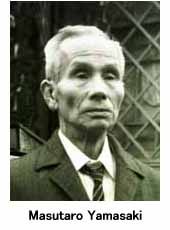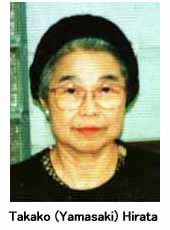Peace Features
Testimonies by a Father and his Older Daughter
(July 14, 2008)
Satoko Yamasaki, age 13
 Satoko was in her second year at Hiroshima Municipal First Girls High School, today known as Funairi Senior High School. After losing her mother to an illness when she was a young child, Satoko lived with her father (Masutaro Yamasaki) and her older sister (Takako Yamasaki) at the printing shop run by her uncle and aunt in Tenjin-machi, Hiroshima. She was working as a “mobilized student” in the Kako-machi area of Naka Ward, central Hiroshima, at the time of the bombing. She died on her father’s back after he had rushed to the site to rescue her. More than 530 first- and second-year high school girls perished there.
Satoko was in her second year at Hiroshima Municipal First Girls High School, today known as Funairi Senior High School. After losing her mother to an illness when she was a young child, Satoko lived with her father (Masutaro Yamasaki) and her older sister (Takako Yamasaki) at the printing shop run by her uncle and aunt in Tenjin-machi, Hiroshima. She was working as a “mobilized student” in the Kako-machi area of Naka Ward, central Hiroshima, at the time of the bombing. She died on her father’s back after he had rushed to the site to rescue her. More than 530 first- and second-year high school girls perished there.
Masutaro Yamasaki
Mr. Yamasaki was working at the head office of Chugoku Power Distribution Company (now Chugoku Electric Power Company) when the bomb exploded. Although only 0.7 kilometers from the hypocenter, he somehow survived. His original comments, entitled “Misery on the Motoyasu River,” were published in 1957 in “Ryuto” (“Floating Lanterns”), compiled by the Bereaved Families Association of Hiroshima Municipal Girls High School. He served as auditor at Chugoku Power Distribution Company until 1951. He died in 1975 at the age of 84.
Takako (Yamasaki) Hirata
Ms. Hirata was in her fourth year at Hiroshima Prefectural First Girls High School (now, Minami High School) at the time of the bombing. She was staying at her uncle’s home while working as a mobilized student at the nearby Second General Army Headquarters in Hiroshima. The headquarters had been set up in April 1945 as a major defense base for western Japan. She was 68 years old and living in Yokohama at the time she gave this statement about her sister.
Statement by Satoko’s father, Masutaro Yamasaki: “She suddenly seemed heavier…then I realized Satoko had died.”
In those days we were living in Tenjin-machi. Satoko, a second-year student at the Municipal Girls High School, had left home in the morning to work at a building demolition site near the prefectural government office and Shinbashi Bridge. After the blast, I was very worried about her so I set out to find her.
Shinbashi Bridge, spanning the Motoyasu River, was half-collapsed, so I waded across the river in the waist-deep water. What a tragic sight! On the riverbank lay dozens, maybe hundreds of girls, injured, unconscious, or already dead. Some of the girls were still writhing a little, letting out weak moans.
I was stunned to see that all of them were stark naked. Their clothing had completely burned away and their bodies were dark-red, the color of boiled octopus. It was a hellish scene.

When the bomb exploded, I was working on the second floor of my company’s building. I was knocked unconscious and when I awoke several minutes later, everything was pitch dark. I couldn’t see an inch ahead of me.
I imagine the blast also hurled the girls to the ground, knocking them unconscious, as fire spread toward them. When they came to, they found themselves in flames. They must have stumbled down to the riverbank screaming. Some may have died in the fire without ever stirring.
I finally found Satoko. Like the others, she was severely burned. A scrap of towel and her name tag were by her body and a pouch remained fastened around her waist. Her skin had turned yellow and her face was swollen.
“Father, my throat hurts.” I quickly scooped up some water from the river for her. Thinking back on it now, that water must have been radioactive.
Our house, which had stood on the same riverbank, was burned to the ground. At that time my older daughter was staying with relatives in Ushita. As I was worried about her, too, I decided to head there with Satoko on my back.
I waded into the river but the water came up to my waist. As I was weak myself, my legs wobbled and I was afraid I might fall at any moment, dropping Satoko into the river. I didn’t know what to do.
Luckily, some soldiers appeared and rescued us. We were taken to shore on the other side of the river and, from there, we reached the Western Drill Ground. A large number of people were resting at the drill ground, including some coworkers of mine.
I stopped and rested there a while, too, then stood up again with Satoko on my back. But she suddenly seemed heavier so I asked Mr. Takemoto, from my company, to help me lift her. Instead, he told me to set her down. I was startled, sensing something was wrong. And then I realized that Satoko had died. I went utterly numb.
From there I carried her through Hatchobori and over the Tokiwa Bridge to the far end of the levee in Ushita. Along the way I would walk 100 meters, rest for five minutes, walk another 150 meters and rest for fifteen minutes. I thought I would keel over myself. It was like a long journey through a dream.
Statement by Satoko’s sister, Takako (Yamasaki) Hirata: “I spent two nights driving away the flies that swarmed over her decomposing body.”
On August 6, I was at my relatives’ home in Ushita, 2.5 km from the hypocenter, with my aunt and her daughter, a second-grader in elementary school. There was a momentary flash and then a blast that collapsed the tatami-mat floor and shattered the sliding paper doors and screens. I thought a bomb had hit us directly. Quite some time passed before we had treated our wounds and learned that the city was in chaos.
My father then appeared, carrying my little sister on his back, her lifeless body covered with burns. His shoes and wristwatch were gone and he wore a blood-soaked towel around his head as a bandage for two big lacerations, each five centimeters long. He had found my sister near the west end of the present Peace Bridge and was somehow able to carry her home. I still grieve when I think of that moment.
Satoko’s skin had peeled off and her flesh had the appearance of a sliced sausage. I put down a cushion next to her and I spent two nights driving away the flies that swarmed over her decomposing body.
 On the morning of August 8, the head of our neighborhood association informed us of plans for the disposal of the dead. My father and I wrapped Satoko in straw mats and carried her to a park in Ushita. Many rectangular holes had been dug in the ground for cremation of the bodies. Some people were already there, awaiting their turns.
On the morning of August 8, the head of our neighborhood association informed us of plans for the disposal of the dead. My father and I wrapped Satoko in straw mats and carried her to a park in Ushita. Many rectangular holes had been dug in the ground for cremation of the bodies. Some people were already there, awaiting their turns.
In that shadeless park, under a blazing mid-summer sun, we waited amid the smoke and stench of the burning bodies. Finally our turn came and we laid Satoko carefully on top of the unburned bones of some previously cremated bodies.
The fire from the straw mats was not enough to consume Satoko’s body, which had lost fat as a result of her previous burns, so we collected leaves and branches and scattered them over the unburnt remains. My father and I gazed blankly as Satoko rose in smoke. We had been told to put out the fire with water if an air-raid siren sounded, and I remember feeling relieved just because we didn’t have to do that.
We then placed her ashes in a small pot and trudged single-file along a narrow path through the fields, accompanied by our tremendously long shadows in the evening sun. I’ll never forget that scene, but to this day it’s still disheartening that I can’t even begin to convey what I really experienced.
Every day after that, we went to the site of our burnt-out home in Tenjin-machi. The ruins of Hiroshima spread into the distance in all directions and the sight of the burnt bodies floating in the river was beyond description. After about a month, we found my uncle’s bleached white bones near the entrance, with the charred remains of the woolen waistband that he had always worn. After a diligent search we discovered my aunt’s bones where the living room had been. More bones were found beneath the printing machine, but despite my father’s efforts, they have never been identified. Another uncle was at the Western Drill Ground when the bomb struck, and he died a month later.
After my own exposure to the bomb, I suffered continuing hair loss and bleeding gums. I think I received my first bomb-related medical examination around 1958. My white blood cell count was less than 3000. In those days, when viewing my son, who was in elementary school, and my daughter, a kindergartener, I was tormented by fear, anxiety, and insomnia. Now my children are grown and I can feel happy when I hug my three grandchildren. I am grateful to be alive, though I still have to tend to my ailments.
After I got married, my father insisted on living alone in Hiroshima. I’ve moved many times because of my husband’s job transfers. In Yokohama where we now live, my father came to live with us for about five years but still kept his official residency in Hiroshima. His sorrow over Satoko’s death lasted to the end of his days. His grief, and my own experience with the atomic bomb, have left me with pain that can never go away.


